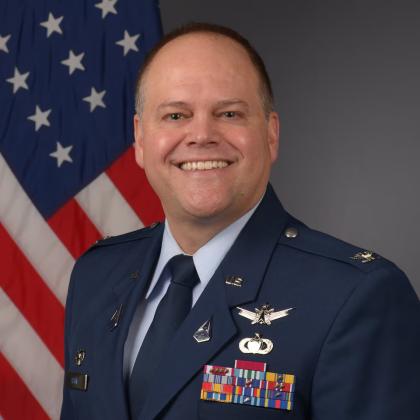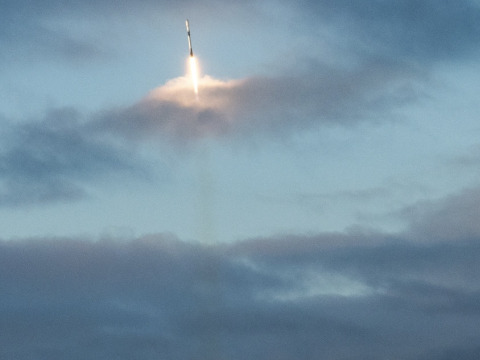Space Prepares for Groundbreaking ULA National Security Launch
The U.S. Space Force (USSF) will launch United Launch Alliance’s (ULA's) Vulcan Centaur rocket Tuesday evening from Space Launch Complex 41 at Cape Canaveral Space Force Station, Florida.
Dubbed the USSF-106 mission, the Vulcan Centaur will carry several classified payloads, including the so-called Navigation Technology Satellite-3 (NTS-3), straight into geosynchronous (GEO) orbit. This is the first national security-related space launch on the Vulcan Centaur rocket.
The $250 million effort includes about 100 experiments over the next year related to position, navigation and timing (PNT), GPS and other capabilities. It is the first such experimental satellite in 48 years.
“We are excited to be here today, a historic point in our program history,” said Col. Jim Horne, USSF, mission director and senior materiel leader, Space Systems Command, during a Space Systems Command media call Monday.
“We officially end our reliance on Russian-made [rocket] engines with this launch,” he said. “And we continue to maintain our assured access to space with at least two independent rocket service companies that we can leverage to get our capabilities on orbit.”
In July, Horne also stepped into the role of commander of Space Launch Delta 30 and Western Launch and Test Range, Vandenberg Space Force Base, California. Given the planned launch schedule, Horne kept on with his mission director and materiel leader roles for the Vulcan, overseeing two certification launches this spring.
The launch vehicle successfully rolled to the pad Monday morning, reported Gary Wentz, vice president of government and commercial programs, ULA. It was a welcomed status for the vehicle after several long delays.
“This mission is extremely important to ULA,” Wentz noted. “I want to thank our mission collaborators. This will be the most powerful Vulcan yet. And this mission is headed directly to geosynchronous orbit and will be one of our longest missions to date. It was purposely designed to support these missions, going directly to GEO for the Space Force.”
The NTS-3 satellite will serve as the basis for about 100 experiments, said Joanna Hicks, senior research aerospace engineer, Air Force Research Laboratory (AFRL). And most notably, NTS-3 will be able to connect signals not only from GEO but also lower-earth orbit and mid-Earth orbit.
“We are experimenting with how to have more than one orbit so that we are no longer constrained to only be in GEO for the PNT mission,” Hicks clarified. “One of the things that you do get out of GEO is that you have at least one satellite in view that is persistent in a given part of the world, and that offers some unique opportunities because we can experiment with concepts that we call augmentation, where you're still receiving GPS signals, but then you have additional signals that are coming from the NTS-3 satellite in GEO that can provide additional information that helps in a supporting role for the GPS signals.”
Andrew Builta, vice president of strategy and business development and program management excellence, L3Harris Technologies, emphasized that the launch of NTS-3 will demonstrate the best next-generation technologies on orbit and help develop new techniques for space operations, the ground control and user equipment segments.
“NTS-3 was designed to be modular, scalable and make use of investments by commercial industry,” Builta said. “This allows the payload components to be configured for diverse applicability to unique requirements.”
The experimental satellite will be the first U.S. navigation system to integrate advanced array technologies that can focus powerful beams to forces on the ground as well as combat jamming environments, he added.
Another key feature of the satellite is the reprogrammable nature of its receiver, so experiments can change as more technologies are developed across multiple time scales, Hicks and Builta said.
“Its signal processors provide unprecedented flexibility to support different signal types and strengths, and it is capable of being reprogrammed on orbit,” Builta said. “This is a truly game-changing capability.”
In addition, the experiments will demonstrate how quickly and efficiently new signals can be added after satellite delivery. “What historically required a new satellite block of production and design can now be added within a few weeks,” he noted.
For example, the AFRL and the Space Force will conduct experiments that involve the AFRL-developed CHIMERA (chips–message robust authentication) signal, the GPS spoofing-resistent filtering signal enhancement effort. Hicks noted that after the CHIMERA experiments, the AFRL hopes to share the results with universities and other international partners.

We officially end our reliance on Russian-made [rocket] engines with this launch.
And naturally, the scientists will test the transmission of certain information from the satellite, to receive it on the ground followed by a lot of processing.
“Some of those will be in a lab, where we are piping signals into a lab to do our processing, and some of them we anticipate would be in a field environment, where we are trying to replicate conditions that the warfighter might experience," Hicks said. "Also, particularly when it comes to clocks and timekeeping, we have experiments that are taking place on board the satellite, and we are piping that data down to be looked at.”
Regarding the progression of experiments over the next year, the AFRL and the Space Force will begin with efforts “that are more of a calibration and characterization nature, understanding our system, knowing how it works,” Hicks stated.
Once the scientists are confident in the system operations, they will start experimenting with the more simple and straightforward capabilities, followed by more complicated activities that involve integration of several technologies together into a demonstration.
Hicks said she expects the hardest set of experiments will involve the phased array antenna.
“It is a complicated system, so there are a lot of different aspects that we have to control in order to take in good data,” she stated. “From an engineering perspective, the hardest thing is making that reprogrammability work across all the segments and operate in a seamless fashion.”
After the year-long experimental mission, the AFRL and the Space Force will see if other organizations could use NTS-3 for other testing purposes—assuming the spacecraft still has more lifespan.
“At AFRL, every satellite we fly is a one-off,” Hicks noted. “We don't do things that we've done before. Hopefully, within a few weeks here, we should be able to start collecting data."



Comments